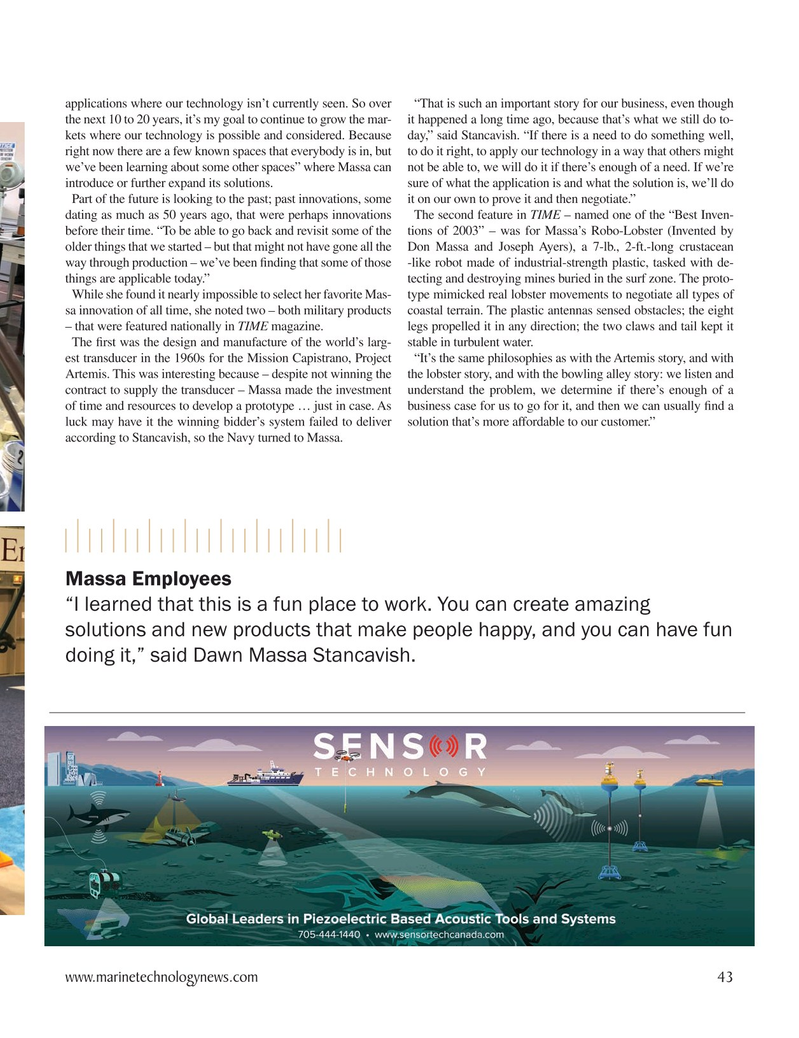
Page 43: of Marine Technology Magazine (May 2022)
Read this page in Pdf, Flash or Html5 edition of May 2022 Marine Technology Magazine
applications where our technology isn’t currently seen. So over “That is such an important story for our business, even though the next 10 to 20 years, it’s my goal to continue to grow the mar- it happened a long time ago, because that’s what we still do to- kets where our technology is possible and considered. Because day,” said Stancavish. “If there is a need to do something well, right now there are a few known spaces that everybody is in, but to do it right, to apply our technology in a way that others might we’ve been learning about some other spaces” where Massa can not be able to, we will do it if there’s enough of a need. If we’re introduce or further expand its solutions. sure of what the application is and what the solution is, we’ll do
Part of the future is looking to the past; past innovations, some it on our own to prove it and then negotiate.” dating as much as 50 years ago, that were perhaps innovations The second feature in TIME – named one of the “Best Inven- before their time. “To be able to go back and revisit some of the tions of 2003” – was for Massa’s Robo-Lobster (Invented by older things that we started – but that might not have gone all the Don Massa and Joseph Ayers), a 7-lb., 2-ft.-long crustacean way through production – we’ve been ? nding that some of those -like robot made of industrial-strength plastic, tasked with de- things are applicable today.” tecting and destroying mines buried in the surf zone. The proto-
While she found it nearly impossible to select her favorite Mas- type mimicked real lobster movements to negotiate all types of sa innovation of all time, she noted two – both military products coastal terrain. The plastic antennas sensed obstacles; the eight – that were featured nationally in TIME magazine. legs propelled it in any direction; the two claws and tail kept it
The ? rst was the design and manufacture of the world’s larg- stable in turbulent water.
est transducer in the 1960s for the Mission Capistrano, Project “It’s the same philosophies as with the Artemis story, and with
Artemis. This was interesting because – despite not winning the the lobster story, and with the bowling alley story: we listen and contract to supply the transducer – Massa made the investment understand the problem, we determine if there’s enough of a of time and resources to develop a prototype … just in case. As business case for us to go for it, and then we can usually ? nd a luck may have it the winning bidder’s system failed to deliver solution that’s more affordable to our customer.” according to Stancavish, so the Navy turned to Massa.
Massa Employees “I learned that this is a fun place to work. You can create amazing solutions and new products that make people happy, and you can have fun doing it,” said Dawn Massa Stancavish.
www.marinetechnologynews.com 43
MTR #4 (34-49).indd 43 4/29/2022 2:38:37 PM

 42
42

 44
44
